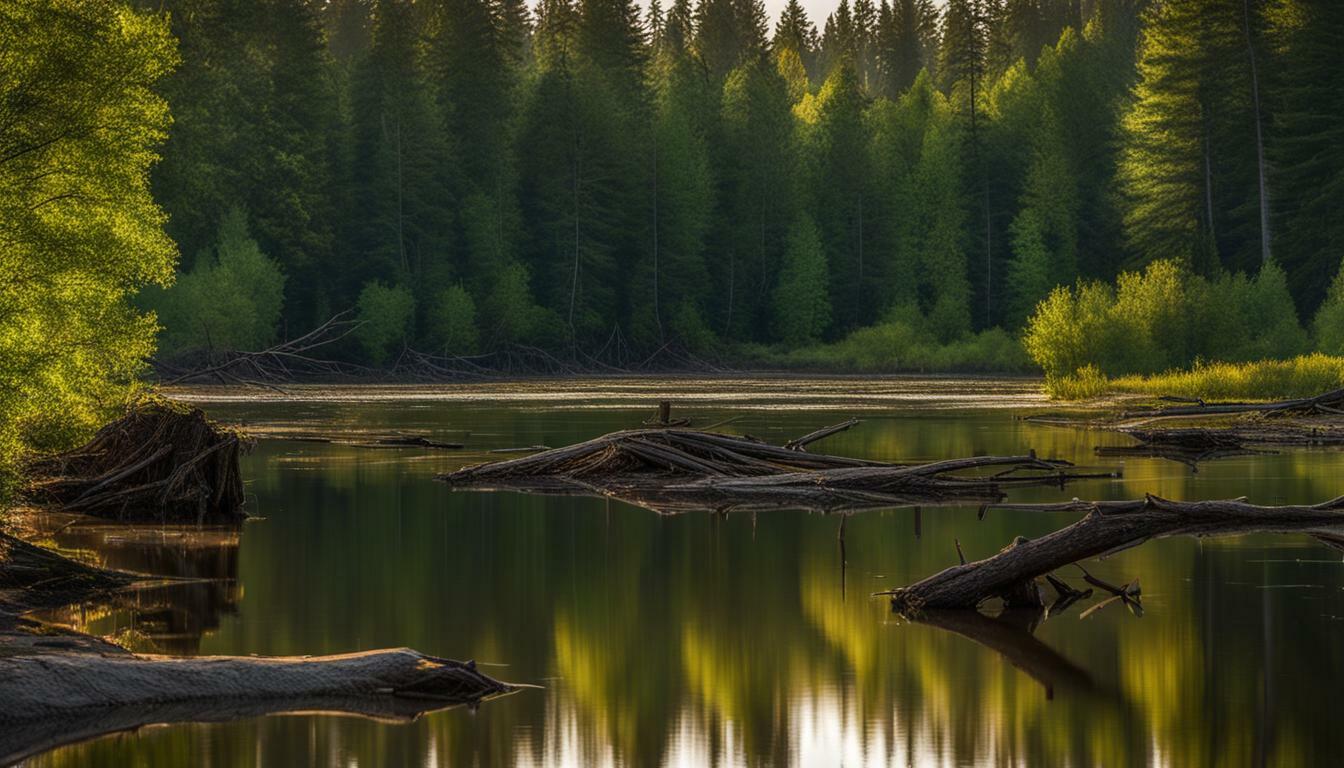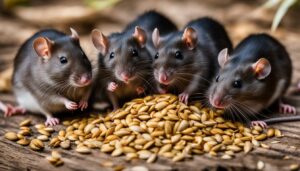Indiana is home to a thriving beaver population, with these dam-building mammals being a fascinating part of the state’s ecosystem. The North American beaver (Castor Canadensis) can be found in Indiana, and they play an important role in shaping the landscape and maintaining biodiversity.
Beavers are the largest rodent in the world and can weigh between 45 and 60 pounds, with some reaching up to 100 pounds. They are known for their distinctive orange front teeth, which grow continuously throughout their lives. Beavers have a wide, Naked tail that helps them swim efficiently and manipulate water.
These sociable and busy animals are known for their impressive architectural skills. They build lodges with complex underwater entrances and construct dams to create calm waters, which provide habitat for a variety of other species.
Beavers are omnivores and primarily eat vegetation, including aquatic plants, twigs, leaves, and soft tree tissue. They do not eat bark or wood but use them to maintain their teeth and build their structures.
While beavers are beneficial for the ecosystem, their activities can sometimes cause problems around residential or commercial areas. These include plumbing damage, flooding, and hazards from tree trunk gnawing. In such cases, it is recommended to contact a local and licensed wildlife control company for beaver removal and control services. Trapping beavers is also an option until March 15, and shooting beavers is allowed if they are damaging property.
Key Takeaways:
- Indiana is home to a thriving beaver population
- Beavers are dam-building mammals and play a vital role in the ecosystem
- They are the largest rodent in the world and have distinctive orange front teeth
- Beavers build lodges and dams, creating calm waters and providing habitat for other species
- They are omnivores and primarily eat vegetation
Beaver Sightings in Indiana
Many residents and nature enthusiasts in Indiana have had the pleasure of spotting beavers in the wild, adding to the richness of the state’s wildlife. These incredible creatures can be found in various waterways and wetland areas across Indiana, where they leave their mark through dam-building and lodge construction.
Beaver sightings in Indiana have been reported in numerous counties, including Lake, Porter, La Porte, and Allen. These sightings serve as a testament to the adaptability of beavers, as they can thrive in both urban and rural environments. Whether you’re exploring a state park or simply taking a stroll near a river, keep an eye out for these industrious rodents.
Notable Beaver Sightings:
| County | Sighting Location | Date |
|---|---|---|
| Lake | Wolf Lake | June 12, 2021 |
| Porter | Indiana Dunes State Park | September 5, 2021 |
| La Porte | Potato Creek State Park | July 18, 2021 |
| Allen | St. Joseph River | August 29, 2021 |
While beavers are generally elusive and active during the dawn and dusk hours, patient observers may catch a glimpse of these fascinating creatures during daylight as well. Remember to maintain a respectful distance and avoid any actions that may disturb their natural behavior.
Next time you’re out and about in Indiana, keep your eyes peeled for beavers in their natural habitats. Their presence is a testament to the state’s diverse wildlife and the importance of conservation efforts to protect these remarkable animals.
Beaver Characteristics and Behavior
Beavers play a crucial role in the Indiana ecosystem, shaping landscapes and creating habitats for various other species. These sociable and busy animals are the largest rodents in the world, weighing between 45 and 60 pounds, with some individuals reaching up to 100 pounds. They are easily recognizable by their long, orange front teeth, which are known for their wear and tapering due to gnawing on wood. Beavers also have wide, Naked tails, which they use for swimming and manipulating water. Their thick, double coat of brown fur helps them repel water and stay warm in cold temperatures.
One of the remarkable behaviors of beavers is their ability to construct dams and lodges. They build dams across streams and rivers to create calm waters, which provide protection and easier access to food. These dams also help in maintaining water levels, preventing floods, and recharging groundwater. Beavers are highly skilled engineers, creating complex lodges with underwater entrances to shield themselves from predators. These structures serve as safe havens for their families, with separate chambers for resting, raising young, and storing food.
Beaver Diet
Beavers are primarily herbivores, consuming a wide variety of vegetation. Their diet consists of aquatic plants, twigs, leaves, and soft tree tissue. However, contrary to popular belief, beavers do not eat bark or wood. Instead, they gnaw on it to sharpen their teeth or use it to construct their dams and lodges. This diet has a significant impact on the landscape, contributing to the growth of wetlands and creating diverse habitats for numerous species.
| Ecosystem Impact | Benefits | Challenges |
|---|---|---|
| Beavers create wetlands, which act as natural filters, improving water quality and reducing pollution. | Beavers create habitats for various species, including fish, amphibians, birds, and mammals. | Beaver activity can sometimes lead to flooding, tree damage, and conflicts with human infrastructure. |
| Beaver dams help maintain water levels, preventing both droughts and floods. | Beavers promote biodiversity by creating a mosaic of different habitats within the landscape. | Beaver activity can cause nuisance issues around residential or commercial areas, requiring management and control measures. |
In cases where beaver activity poses problems, it is recommended to contact a local and licensed wildlife control company for beaver removal and control services. Trapping beavers is another option, which must be done before March 15. Shooting beavers is allowed if they are causing property damage, but it is important to report the taking of the animal to a conservation officer within 72 hours. Balancing the preservation of beavers and the management of their populations is essential for a harmonious coexistence with these fascinating creatures in Indiana.
Beaver Habitats in Indiana
Beavers in Indiana can be found in a variety of habitats, ranging from rivers and streams to ponds and wetlands. These semi-aquatic mammals are well adapted to life in the water and are skilled engineers when it comes to altering their surroundings to meet their needs.
One of the key habitats for beavers in Indiana is rivers and streams. They prefer areas with slow-moving or still water, where they can construct their lodges and dams. Beavers are known for building dams across streams to create calm, deep pools of water, which provides them with a safe place to live and raises the water level to reach their food sources.
Another important habitat for beavers in Indiana is ponds and wetlands. These areas offer plenty of vegetation, both in and around the water, which serves as a vital food source for beavers. Ponds and wetlands provide an ideal environment for beavers to build their lodges and create their dams, as the water levels are generally higher and there is an abundance of food and shelter.
| Habitat | Key Features |
|---|---|
| Rivers and Streams | Slow-moving or still water, ideal for dam-building |
| Ponds and Wetlands | Plenty of vegetation, both in and around the water |
These habitats are crucial for maintaining a healthy beaver population in Indiana. However, there are instances when beavers may cause problems around residential or commercial areas, such as plumbing damage, flooding, and the risk of tree trunk gnawing. In such cases, it is recommended to contact a local and licensed wildlife control company for beaver removal and control services. Trapping beavers is also an option and can be done until March 15. Shooting beavers is allowed if they are damaging property, but the taking of the animal must be reported to a conservation officer within 72 hours.
Beaver Biology and Diet
Beavers possess remarkable adaptations that allow them to construct complex dams and lodges, contributing to their success as a species in Indiana. These dam-building mammals play an important role in the ecosystem, creating habitats that support a diverse range of wildlife. Let’s explore the fascinating biology and diet of these industrious creatures.
Beavers have unique characteristics that enable them to thrive in their watery environments. Their front teeth, which are orange and strong, continue to grow throughout their lives, allowing them to continually gnaw on wood and build their remarkable structures. With their wide and naked tails, beavers are excellent swimmers, using their tails as rudders to navigate through the water swiftly. Their thick double coat of brown fur provides insulation and waterproofing, keeping them warm and dry even in cold temperatures.
As herbivores, beavers primarily feed on vegetation, including aquatic plants, twigs, leaves, and soft tree tissue. They do not eat bark or wood, but rather gnaw on it to sharpen their ever-growing teeth or use it as building material. With their expert engineering skills, beavers create dams by felling trees and strategically placing branches and mud, which form an intricate network that diverts water flow, creates calm ponds, and provides protection.
Beaver Biology and Diet: Key Points
- Beavers possess adaptations that allow them to build dams and lodges, contributing to their success in Indiana.
- Their distinctive features include orange, strong front teeth, wide naked tails for swimming, and a thick double coat of brown fur.
- Beavers are herbivores and mainly consume aquatic plants, twigs, leaves, and soft tree tissue.
- They gnaw on wood to sharpen their teeth and use it for construction purposes.
- By creating dams, beavers alter water flow, create calm ponds, and provide habitat for various species.
While beavers’ activities can sometimes cause issues near human settlements, it’s important to remember their vital role in shaping the environment and supporting biodiversity. In cases where beavers pose a threat to residential or commercial areas, it is recommended to contact a local and licensed wildlife control company for their safe removal and control. Trapping these animals is an option, and it is allowed until March 15. If beavers are causing significant property damage, shooting them is permitted, but it is essential to report the taking of the animal to a conservation officer within 72 hours.
| Beaver Biology and Diet: Key Facts |
|---|
| The beaver is the largest rodent in the world. |
| Beavers typically weigh between 45 and 60 pounds, but some can reach up to 100 pounds. |
| They have a distinct tapered look to their front teeth due to constant wear. |
| Beavers are sociable creatures that mate for life and construct lodges with complex underwater entrances. |
Challenges and Benefits of Beaver Activity
While beavers offer numerous benefits to the Indiana ecosystem, their activities can sometimes pose challenges to human environments. These industrious creatures play a vital role in maintaining wetlands and supporting diverse wildlife populations. By building dams, beavers help create calm waters that attract a variety of aquatic plants and animals. Their lodges provide shelter for themselves and other species, fostering a rich and vibrant ecosystem. Additionally, the dams they construct can help regulate water flow, prevent erosion, and mitigate the impacts of floods.
However, beaver activity can also bring about challenges, particularly when they come into contact with residential or commercial areas. The gnawing of tree trunks can pose hazards to people, and their dam-building efforts can lead to waterlogged properties and flooding. Additionally, their burrowing activities may damage plumbing systems, causing expensive repairs. It is essential to find a balance between the benefits of beavers and minimizing potential conflicts with human environments.
Managing Beaver Populations in Indiana
To address the challenges associated with beaver activity, the state of Indiana has implemented various strategies for managing beaver populations. One approach is to work with licensed wildlife control companies that specialize in beaver removal and control services. These professionals can safely and effectively address issues caused by beavers, ensuring the protection of both human property and the beaver population.
Trapping is another option that can be employed until March 15, following the guidelines set forth by the Indiana Department of Natural Resources. Additionally, shooting beavers is allowed if they are causing significant property damage, but it is crucial to report the taking of the animal to a conservation officer within 72 hours. These measures aim to maintain a balance between the needs of human environments and the preservation of beavers in the Indiana ecosystem.
| Challenges | Benefits |
|---|---|
| Tree trunk gnawing poses hazards to humans | Creation of wetlands that support diverse wildlife |
| Flooding and waterlogged properties | Regulation of water flow and prevention of erosion |
| Damage to plumbing systems | Mitigation of the impacts of floods |
By carefully managing beaver populations and implementing strategies that promote coexistence, Indiana can continue to reap the benefits that these remarkable animals provide. Ensuring the protection of both human environments and the natural habitats of beavers is vital for maintaining a healthy and thriving ecosystem in the state.
Beaver Removal and Control
If beaver activity becomes problematic around your property in Indiana, there are options available for their removal and control. When dealing with beavers, it is important to remember that they are protected under state law. Therefore, it is recommended to contact a local and licensed wildlife control company that specializes in handling beaver-related issues.
Trapping is a common method used for beaver removal. Licensed professionals can set up traps in strategic locations to safely catch and remove the beavers from your property. It is crucial to follow all regulations and guidelines regarding trapping, which may include obtaining necessary permits and adhering to specific trapping seasons. In Indiana, trapping beavers is allowed until March 15.
In some cases, shooting beavers may be allowed if they are causing significant damage to property. However, it is important to note that shooting beavers should be seen as a last resort and should only be done after consulting with local authorities. If shooting is deemed necessary, it is essential to report the taking of the animal to a conservation officer within 72 hours.
| Beaver Removal and Control Options: |
|---|
| 1. Contact a local and licensed wildlife control company specialized in beaver removal. |
| 2. Follow all regulations and guidelines regarding trapping, obtaining permits if required. |
| 3. Shoot beavers only as a last resort and after consulting with local authorities. Report the taking of the animal within 72 hours. |
When dealing with beavers, it is important to prioritize the safety of both the animals and the surrounding environment. Working with professionals who understand the behavior and habits of beavers will ensure a humane and effective approach to their removal and control.
Protecting Beavers in Indiana
It is vital to recognize the value of beavers in the Indiana ecosystem and to implement measures that ensure their conservation. These industrious creatures play a crucial role in maintaining the balance of our wildlife and natural habitats. By understanding their importance and taking appropriate steps, we can protect and coexist with beavers in a way that benefits both humans and wildlife.
The Benefits of Beavers
Beavers contribute significantly to the ecosystem by creating wetlands and enhancing biodiversity. Their dam-building activities help to control water levels, prevent erosion, and improve water quality by filtering out pollutants. Wetlands created by beavers provide habitat for various species, including fish, amphibians, and waterfowl. Additionally, these structures can act as carbon sinks, helping to mitigate the effects of climate change. By supporting beaver populations, we can preserve these ecological benefits and ensure the long-term health of our environment.
| Challenges | Solutions |
|---|---|
| Damage to property, plumbing, and trees | Contact a licensed wildlife control company for removal and control services |
| Flooding and water level management | Implement flow devices or water level control structures in collaboration with wildlife experts |
| Conflicts with human activities | Develop buffer zones and educate the public about the benefits of beavers |
Conservation and Coexistence
To protect beavers in Indiana, it is essential to adopt conservation practices that balance human needs with the natural environment. This includes managing beaver populations sustainably through relocation programs and educational initiatives. By raising awareness about the positive ecological impact of beavers and implementing responsible management strategies, we can foster a harmonious coexistence between humans and these fascinating creatures.
Remember, if beaver activity poses a problem in your area, it is recommended to contact a local and licensed wildlife control company for assistance. Trapping beavers is an option until March 15, and shooting is allowed if they are causing property damage, but proper reporting to a conservation officer is mandatory within 72 hours. By approaching beaver management responsibly and respecting their ecological significance, we can ensure a thriving environment for both humans and wildlife in Indiana.
Conclusion
In conclusion, Indiana is indeed home to beavers, with their presence adding to the biodiversity and ecological balance of the state. The North American beaver, also known as Castor Canadensis, is the largest rodent in the world and can be found in Indiana. Weighing between 45 and 60 pounds, beavers are known for their distinctive orange front teeth that are long and strong. They have a tapered look to their teeth due to wear, and their wide, naked tails help them swim and manipulate water. Their thick, double coat of brown fur repels water and keeps them warm.
Beavers are sociable and busy creatures that mate for life. They build lodges with complex underwater entrances and construct dams to create calm waters. These dams serve multiple purposes, from providing a habitat for beavers to altering the landscape and creating wetland environments.
As omnivores, beavers mainly feed on vegetation, including aquatic plants, twigs, leaves, and soft tree tissue. While they do not eat bark or wood, they gnaw on it to sharpen their teeth or use it to build their dams and lodges. While beavers play a crucial role in maintaining the ecosystem, their activity can sometimes cause problems around residential or commercial areas, such as plumbing damage, flooding, and hazards from tree trunk gnawing.
In such cases, it is recommended to contact a local and licensed wildlife control company for professional beaver removal and control services. Trapping beavers is an option available until March 15, and shooting beavers is allowed if they are causing property damage. However, it is important to remember that the taking of the animal must be reported to a conservation officer within 72 hours.
FAQ
Are there beavers in Indiana?
Yes, there are beavers in Indiana. The North American beaver (Castor Canadensis) is the largest rodent in the world and can be found in the state.
How much do beavers weigh?
Beavers typically weigh between 45 and 60 pounds, but some have been recorded to reach up to 100 pounds.
What do beaver teeth look like?
Beavers have four long, orange, and strong front teeth. Their teeth have a distinct tapered look due to wear out at the back.
What is the purpose of a beaver’s tail?
Beavers have wide, naked tails that they use to swim fast and manipulate water.
What is a beaver’s coat made of?
Beavers have a thick, double coat of brown fur that repels water.
What do beavers eat?
Beavers are omnivores and mainly eat vegetation, including aquatic plants, twigs, leaves, and soft tree tissue.
Do beavers eat bark or wood?
Beavers do not eat bark or wood, but they gnaw on it to sharpen their teeth or use it to build dams and lodges.
Can beaver activity cause problems?
Yes, beaver activity can sometimes cause problems around residential or commercial areas, such as plumbing damage, flooding, and hazard from tree trunk gnawing.
What should I do if I have beaver problems?
If you have beaver problems, it is recommended to contact a local and licensed wildlife control company for beaver removal and control services.
Can beavers be trapped or shot?
Trapping beavers is an option and can be done until March 15. Shooting beavers is allowed if they are damaging property, but the taking of the animal must be reported to a conservation officer within 72 hours.




